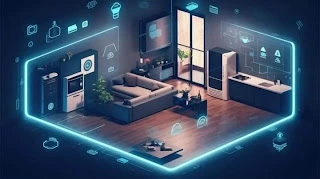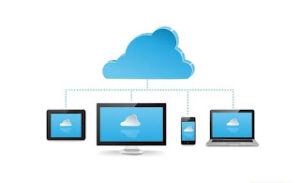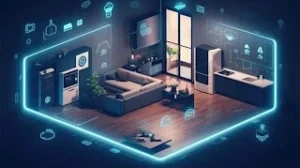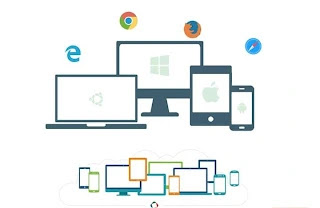In today’s fast-paced era, smart devices play an important role in our lives. They not only make our lives easier, but also save us time and make us more productive.
A smart device is an electronic device that is connected to other devices or networks, typically via various wireless protocols (such as Bluetooth, ZigBee, near-field communication, Wi-Fi, NearLink, Li-Fi, or 5G), and is interactive to some extent and Can work autonomously.
Some of the notable smart devices are: smartphones, smart speakers, smart cars, smart thermostats, smart doorbells, smart locks, smart refrigerators, phablets and tablets, smartwatches, smart bands, smart key rings, smart glasses and many more.
The term can also refer to a device that exhibits some of the characteristics of ubiquitous computing, which may, but not necessarily, include machine learning.
Smart devices are available in a variety of sizes and features and can be used in three main environments:
- Real World: Smart devices can interact with and control the environment around us. For example, smart thermostats can control room temperature and smart locks can open doors remotely.
- Human-centric environment: Smart devices can make our daily tasks easier and improve our quality of life. For example, smart speakers can play music, set alarms and make calls.
- Distributed computing environment: Smart devices can connect with other devices and work together. For example, smart home devices can be connected to a network and controlled with a central application. Smart homes imply the presence of sensors, detection devices, appliances and a database to control them. Smart homes help users control their homes remotely and reduce energy consumption.
How Do Smart Devices Work?
- Smart devices are environment and context aware. That is, it is a system that continuously gathers information about its environment and has the ability to change behavior accordingly. Cameras, microphones, global positioning system (GPS) receivers, radar and lidar sensors are all potential sources of data or information for context-aware computing. A context-aware system can collect data through these elements and other sources. and can respond according to pre-established rules or through computational intelligence.
- Smart devices have automated computing systems. The essence of automated computing is that a device or multiple devices perform tasks automatically without direct instruction from the user. For example, our smartphones give us suggestions based on our location or the weather. To perform this simple task, a smartphone needs to be automated and use relevant information to make decisions.
- Smart devices have the ability to connect. Connectivity refers to the ability of a smart device to connect to a data network. Without connectivity, the automation and context awareness of a smart device makes no sense. Network connectivity, whether wired or wireless, is an important feature that enables a device to be part of the Internet of Things (IoT).
- Smart devices rely on the Internet of Things (IoT) to connect with sensors. These sensors are attached to objects or other network-connected devices and collect data from their surroundings. Smart devices can store this data, share it with other smart devices, and analyze the information for users. If multiple smart devices are connected to the same network, one platform or device can be used to manage the different smart devices. As long as there is an Internet connection, smart devices have the ability to share information and communicate with each other, making it easy to send data and monitor devices.
- Not all smart devices are designed to interact with humans. A smart device can have direct or indirect interaction with humans. For example, a weather monitoring device can collect weather data and send it to the IoT. Humans will certainly use that data, but weather monitoring instruments do not require any direct interaction with humans.
Intelligent Companion Smart Device
Smart devices are not just electronic devices, but intelligent companions connected to the surrounding environment. They collect data through sensors, cameras, microphones, etc. For example, a smart phone’s accelerometer sensor can sense the user’s walking pattern.
The collected data is analyzed by the device with the help of its processor, memory and software and takes necessary calculated decisions. For example, smart thermometers measure the temperature and can decide to turn on the air conditioner accordingly.
The device then communicates information with other devices or services through networks, antennas, etc. It can send results and receive instructions from other devices.
Ultimately, the device performs its task based on the results of the analysis of the collected data or the instructions received from another device. It changes the environment or performs other functions using speakers, screens or other devices. For example, a smart light can automatically turn on after receiving information from a dimming sensor.
Smart Devices Are Making Life Easier
These devices make our life easier in many ways. For example, smartphones help us stay connected to the Internet, make phone calls, send text messages, send emails, play games, listen to music, and more.
Smart TV helps us stay connected to the internet, watch movies and TV shows from streaming services. Smart refrigerators help keep track of food and order fresh food. Smart washing machine washes and cleans clothes. Smart thermostats help control the temperature of the home. Smart lock helps keep home safe. Smart robot vacuum cleaners help clean the house.
Smart devices make our lives easier and more enjoyable. They save us time and make us more productive.
With the advancement of modern technology, we are seeing many devices becoming smarter. Which were not smart before, are being made into smart versions by adding new technologies.
We can now control these devices using smartphone applications through network connectivity.
Simply put, only those devices can be called smart that can connect to other devices and platforms and are controllable.
Which Devices Are Not Smart?
Many devices in today’s market are marketed as smart, even though they can’t be called smart. Such devices use new technology, but they cannot connect to any network.
For example, just because a watch has an LCD screen doesn’t mean it’s a smartwatch. It will only be a smartwatch when it can connect to the phone or online wirelessly. Similarly, making an analog device or gadget electronic doesn’t mean it’s smart.
A key feature of smart devices is their ability to connect to networks and communicate with other devices. If a device does not have these features, it cannot be called smart.
Examples Of Some Common Smart Devices
There are many devices in our daily life that are smart. Smart TVs, speakers and projectors are quite popular when it comes to home entertainment. Many people use various smart devices for home security, such as smart doorbells, cameras, locks and alarms. Many people can control the bulbs in the house remotely using smart lights.
The room temperature can be controlled using a smart thermostat. Window curtains can be raised or closed remotely using smart blinds. You can control all your smart devices simultaneously using the Smart Home Hub. Wearable devices include smartwatches, bands, glasses, earphones and even smart shoes.
Smart devices work with a combination of hardware, software and network protocols. The hardware layer consists of the physical components that enable the device to function, such as processors, memory, batteries, displays, speakers, microphones, cameras, sensors, actuators, antennas, etc.
Software layer consists of operating system, applications, drivers, firmware etc. Which keeps the device active and functional. The network layer consists of standards and protocols that enable devices to connect to other devices or services. Like bluetooth, wifi etc. Also has NFC, 5G, MQTT, CoAP, HTTP etc. Smart home devices can understand your routine and work on their own according to your needs.
Benefits Of Using Smart Devices
Smart devices not only make personal life easier, but also bring benefits to businesses and communities. They automate, provide information and entertainment to make users’ lives easier and more comfortable.
• Benefits for users
Saves Time: Smart devices can save users a lot of time by automating daily tasks. For example, a smart speaker can play music, set an alarm or order a pizza just by listening to voice commands.
Increases productivity: Smart devices help users to be more productive. For example, a smart thermostat can automatically control the room temperature, which helps users to work attentively in a comfortable environment.
Improves quality of life: Smart devices can improve the quality of life of users. For example, a smart home system allows users to control their home remotely, helping them feel more secure and comfortable.
• Benefits for business
Increases efficiency: Smart devices help increase efficiency in business. For example, a smart factory can automatically produce products, helping businesses reduce costs and increase productivity.
Improves decision making: Smart devices can help businesses make better decisions. For example, a smart sensor system can help business owners identify problems in the production and supply chain of their products.
Creates new markets: Smart devices can create new markets for businesses. For example, a smart health monitoring device can help businesses offer new types of healthcare services.
Besides, the devices used in smart cities increase the livability of the city by controlling traffic, pollution, security etc.
Problems And Risks Of Smart Devices
Smart devices make users’ lives a lot easier, but there are also some risks. There is a risk of an attack by a hacker or someone else, which could compromise the device or user’s information and security.
Hackers can hack the smart camera to see the user’s secret activities. Smart locks and door openers can also be hacked. If software viruses or malware attack the smart device, it may not function properly and may damage other connected devices or services.
Moreover, smart devices can collect, store or share important information about the user or their surroundings. The device may share that information with the device manufacturer, service provider, or other third parties. That information can be misused. Confidential information may be disclosed. For example, smart speakers can record user conversations and send them to the cloud for analysis. A smart meter can reveal the electricity consumption habits and routines of its users.
Apart from this, some more complex problems can arise with smart devices. For example, who owns the data these devices collect? Who will control the way the device works? Who will take responsibility for any damage?
Use Smart Devices Safely And Correctly
Before buying a smart device, find out which company makes it, what features the device has. View opinions, ratings and feedback from other buyers. Please read the Terms, Privacy Policy and User Agreement carefully. Find out what information the device collects, how it uses it and with whom it shares it.
Securely setup and regularly update smart devices after purchase. Use passwords that are difficult to guess. Enable verification methods (such as fingerprint) to ensure that no one but you can use the device. Turn on security and privacy settings and turn off unnecessary features or permissions. Install antivirus, firewall or other necessary software. Backup data and delete when no longer needed.
.
Keep the results and impact of your work in mind when using smart devices. Don’t rely entirely on smart devices, always use your own judgment and intelligence. Make a decision after understanding the benefits and risks of using the device.





